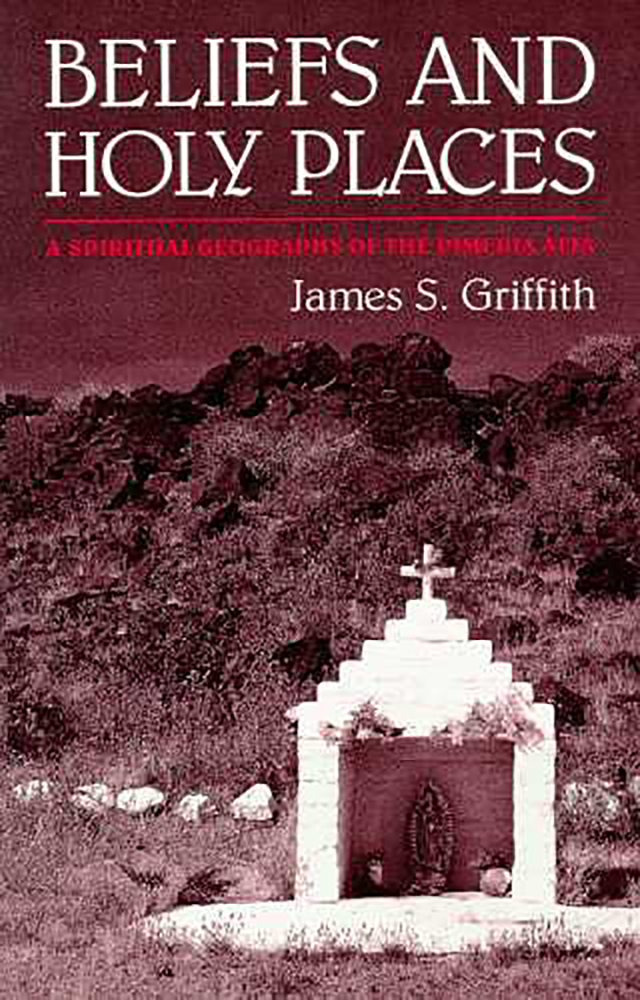Beliefs and Holy Places
A Spiritual Geography of the Pimería Alta
Paperback ($26.95), Ebook ($26.95)
Buy
The region once known as Pimería Alta—now southern Arizona and northern Sonora—has for more than three centuries been a melting pot for the beliefs of native Tohono O'odham and immigrant Yaquis and those of colonizing Spaniards and Mexicans. One need look no further than the roadside crosses along desert highways or the diversity of local celebrations to sense the richness of this cultural commingling.
Folklorist Jim Griffith has lived in the Pimería Alta for more than thirty years, visiting its holy places and attending its fiestas, and has uncovered a background of belief, tradition, and history lying beneath the surface of these cultural expressions. In Beliefs and Holy Places, he reveals some of the supernaturally sanctioned relationships that tie people to places within that region, describing the cultural and religious meanings of locations and showing how bonds between people and places have in turn created relationships between places, a spiritual geography undetectable on physical maps.
Throughout the book, Griffith shows how culture moves from legend to art to belief to practice, all the while serving as a dynamic link between past and future. Now as the desert gives way to newcomers, Griffith's book offers visitors and residents alike a rare opportunity to share in these rich traditions.
Folklorist Jim Griffith has lived in the Pimería Alta for more than thirty years, visiting its holy places and attending its fiestas, and has uncovered a background of belief, tradition, and history lying beneath the surface of these cultural expressions. In Beliefs and Holy Places, he reveals some of the supernaturally sanctioned relationships that tie people to places within that region, describing the cultural and religious meanings of locations and showing how bonds between people and places have in turn created relationships between places, a spiritual geography undetectable on physical maps.
Throughout the book, Griffith shows how culture moves from legend to art to belief to practice, all the while serving as a dynamic link between past and future. Now as the desert gives way to newcomers, Griffith's book offers visitors and residents alike a rare opportunity to share in these rich traditions.
"James Griffith presents the different understandings that different people through time and continuing on today have inscribed upon the area's semiarid topography. . . . Friendly, scholarly, and well written."—The Latin American Anthropology Review
"Griffith paints the spiritual geography of this area with a rich and personal style that almost imitates the Baroque style of church art found throughout Pimeria Alta."—American Desert
"After nearly thirty years of intense personal interest and residence in 'the land of the Pimas,' Griffith chooses places and traditions that have especially strong connections to myth/folklore and lays out for us in good, clean prose his personal account of them. If you have any interest in the traditions of the Southwest, do not miss this important book."—Books of the Southwest
"The Tohono O'odham . . . fascinate the author — and will fascinate the reader too — with their responses both to the landscape and to the cultural influences of their neighbors. . . . The reader will also remember the author's gentle tone. Mr. Griffith writes of the beliefs and customs of people far different from himself in a spirit of restraint and simple decency."—New York Times Book Review
"The anecdotes related in Griffith's book illustrate the geographical configuration of the Pimería Alta as well as the complexity of each cultural group within the region. The stories also reveal the dynamic forces contained in oral history as it is transmitted to each succeeding generation."—New Mexico Historical Review
"It is a testimony to the unheralded aspects of historical traditions that shape our interpretations of the past and that will link the shadowy present to an even more mysterious future. Griffith correctly identifies spirituality as the key link between people and places, between man and the land, and ultimatley between man and God."—Catholic Historical Review
"Griffith paints the spiritual geography of this area with a rich and personal style that almost imitates the Baroque style of church art found throughout Pimeria Alta."—American Desert
"After nearly thirty years of intense personal interest and residence in 'the land of the Pimas,' Griffith chooses places and traditions that have especially strong connections to myth/folklore and lays out for us in good, clean prose his personal account of them. If you have any interest in the traditions of the Southwest, do not miss this important book."—Books of the Southwest
"The Tohono O'odham . . . fascinate the author — and will fascinate the reader too — with their responses both to the landscape and to the cultural influences of their neighbors. . . . The reader will also remember the author's gentle tone. Mr. Griffith writes of the beliefs and customs of people far different from himself in a spirit of restraint and simple decency."—New York Times Book Review
"The anecdotes related in Griffith's book illustrate the geographical configuration of the Pimería Alta as well as the complexity of each cultural group within the region. The stories also reveal the dynamic forces contained in oral history as it is transmitted to each succeeding generation."—New Mexico Historical Review
"It is a testimony to the unheralded aspects of historical traditions that shape our interpretations of the past and that will link the shadowy present to an even more mysterious future. Griffith correctly identifies spirituality as the key link between people and places, between man and the land, and ultimatley between man and God."—Catholic Historical Review
 The University of Arizona Press
The University of Arizona Press

